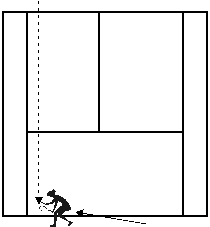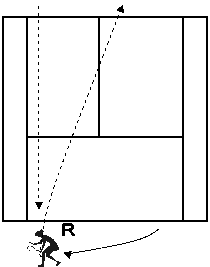|
TennisOne Lessons Receiving the Re-direct Game-Based Situation Training Wayne Elderton Situation Training is a practical application of the international coaching trend called the Game-based approach. It allows players to learn the tactics and techniques required for successful play in real-life situations. In the last installment (called: “Situation training: Baseline Re-direct”) we learned about the tactical decision-making involved in making effective down-the-line shots. This article will explore the other side of the story. What happens when you're on the receiving end of a re-direction down-the-line?
The Story You're a 3.5-5.0 level player in a baseline exchange. The good news is you're rallying well enough to force your opponent to go for risky down-the-line shots. The bad news is, it's paying off for your opponent. Whenever he makes the shot, you scramble over and get to the ball, but you don't do much with it. Your shot pops into the middle of the court and, well, that's all folks! What are you supposed to do with it? How can you make an effective response? We will look at constructing an advantage from this common situation. The Situation Revealed The chart below outlines the shot situation. Watch video clip #1 to get a visual. Roddick (far side) takes Federer's crosscourt and re-directs it down-the-line. Federer then takes Roddick's down-the-line and makes a crosscourt to Roddick's backhand. The crosscourt is effective enough to neutralize the advantage Roddick had with the down-the-line. The exchange continues.
The thing to remember is, in this situation, the player hitting down-the-line is in the risk position. If that player makes a great shot it's their advantage but, he will tend to miss more than get. If the down-the-line is average, you must be able to turn the tables on him to exploit the risk factor. Here is the key: Respond to the opponent's down-the-line with a solid crosscourt When your opponent sends a down-the-line, you must be able to make them pay and chase a good crosscourt response.
A solid crosscourt (off a down-the-line) has three distinct advantages.
In other words, play the shot well and you have the highest percentage shot in tennis that puts your opponent in the most trouble, and makes your recovery the easiest! Not a bad position to be in. You can respond to a down-the-line with a down-the-line, however, this crosscourt response needs to be your bread and butter. The “line to line” play works best as a variation, not the main response.
The truth is, this seems like nothing new. Most coaches and players know about this situation but rarely do they train it in a way that makes it work in real life. It's a play that many players want to do but can't because of lack of practice in that specific situation. The common mistake players make is to move laterally across the baseline with a traditional, ‘cut the ball off diagonally' footwork (see fig 1 and video clip #2). If the down-the-line has any power or depth, it will force you to hit the ball off the bounce with an almost half-volley shot. Now some may say, “isn't hitting early like this good?” The simple answer is, no! This type of on the rise shot is extremely difficult to time and usually results in an uncontrolled hit that pops up to the center of the opponent's court. It won't allow you to consistently stroke on the outside of the ball to direct it crosscourt or lift upward to create a good arc. Also, your momentum by running this direction takes you well past the shot and makes recovery difficult.
The secret to returning an opponent's down-the-line is to make what I call a, “Curved approach to the ball” (see fig 2 & video clip #3). This will allow you to get around the ball and take a full stroke, avoiding sending the ball short and in the middle.
With this approach to the ball, you will be able to make contact at a more comfortable height and send solid crosscourt that has a good arc. A weak crosscourt will give your opponent a clear shot at another down-the-line, a good one will at worst, neutralize your opponent and at best, gain you the advantage. Since you've come around the ball, recovery will be easy (behind the baseline and just on the backhand side of center). Drilling I recommend two drills to practice this situation: Drill#1: Have a partner start in one crosscourt corner and you in the other. To begin, the partner sends a ball down-the-line. Practice the curved footwork, get around the ball and send an arcing crosscourt back. Recover to the right position. Your partner only continues playing if you are successful at neutralizing their down-the-line with a good crosscourt response. If you miss (or they can attack), start again. Alternate starting from each side. Switch roles after 10 attempts.
Drill #2: This is the same drill as the last article on Re-directing with a slight variation. Players start with a live crosscourt rally. At any time, either player can re-direct down-the-line. Down-the-line re-directions must be returned with a crosscourt. The focus this time is to survive the re-direction and continue the crosscourt rally. Play it cooperatively at first and then make it fully competitive. Award a point for every survived re-direction. First to seven wins. Note: to get full practice on this situation, coming to the net is not allowed. Re-directing well and neutralizing re-directions is a fundamental skill for dominating baseline exchanges. Next installment: The point story continues: Dominating the backhand diagonal Your comments are welcome. Let us know what you think about Wayne Elderton's article by emailing us here at TennisOne.
|
||||||||||||||||||||||||||||||||



 Wayne Elderton
Wayne Elderton